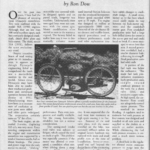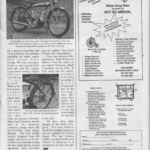Frank Thomas had a better idea. While working as a research design engineer at the Oak Ridge Atomic Energy Project during WWII, he noticed his co-workers struggling with hills and distances on their bicycles. The idea he had was to provide low-cost, reliable transportation using something more than leg power. The result was perhaps the most technically advanced motor kit for a bicycle of the classic era.
Years of research and hundreds of test miles followed. Every previous attempt to motorize a bicycle, both in this country and others, was studied. Finally, after exhaustive tests, the Dynacycle power unit was made available to the public in 1948.
A Revolutionary New Motor Kit This newly designed motor was completely self contained — no extra cables, pulleys or levers to mount. The complete unit attached to the bike (in place of the crank and pedals) with just two bolts. Virtually all the engine’s weight was below the wheel axles, giving what the company claimed to be the lowest center of gravity of any production motorized bicycle in the world. Engine vibration to the frame was minimized by the Dynamount suspension — synthetic rubber bushings inside the bike’s crank housing.
The engine could be attached to any bicycle frame by rotating it around the crank housing until the back of the cylinder head almost touched the down tube. A u-bolt then tightened the top of the engine to the frame.
Two foot pads attached to either side of the engine. The right one acted as throttle, automatic clutch and brake. Pressing the toe down opened the throttle; rocking back with the heal closed the throttle and applied the brake. Operation could not have been simpler! A heavy-duty chain, rear sprocket and hub were also included with the kit. The hub had five inch diameter internal expanding brakes. With over 17” of braking area, effective stops were assured.
The company recommended using 120-gauge spokes for stronger wheels. The Dynamic Clutch transmitted power to the rear wheel. This was basically a simple centrifugal clutch. Early press releases said the engine was to be a 4-stroke, but a 2-stroke is what made it to the market. The 2-stroke engine developed over 4 horsepower and maintained speeds up to 45 miles per hour.
Certain bicycle frames (such as Schwinn) had built-in kickstands that interfered with the motor’s attachment. This was corrected by actually cutting some of the bracket. The bike then rested on the kickstand provided under the left foot rest.
Since most of the gas tank was below the carburetor, the tank was pressurized in order to get the fuel to flow. Loss of pressure inside the tank could cause the engine to barely run at an idle.
A handy oil measure was included under the filler cap. Six capfuls of regular motor oil were needed for the gallon and one-half tank.
The company struggled to gain a foothold in a competitive market. In 1950, due to lagging sales, the company filed for bankruptcy. They re-organized and moved their operations from 3132 Locust Street in St. Louis, Mo., to 2235 O’Fallon St. At the end of 1950, the company unveiled the Dynacycle 165. As a last ditch effort to save the company, now not only was the motor kit available, but also the entire motorbike. The 165 used a heavy-duty frame of Dynacycle design. This frame included a non-functional horn tank, special seat attachment and fenders — all painted dark maroon.
The ride was smoothed with patented telescopic front forks developed by Dynacycle engines. Also standard was an extra lighting coil to power a sealed beam headlight and taillight.
As with the kit, the 165’s engine was air-cooled, 2-cycle at 165cc (hence the name). The price before shipping was $229.50. The engine kit alone was about one hundred dollars less at $122.50, with the lighting coil as an extra option.
The Dynacycle had several distinct advantages over its competition — such as more power and ease of use. So why didn’t it sell better? Allow us to speculate. First, marketing. Whizzer already had a foothold on the market and advertised more extensively—just because a product is designed by gifted engineers does not mean they are marketing geniuses.
Second, mechanics. Engine wear is faster in a 2-cycle engine. A reed valve between the carburetor and engine was a constant source of problems. Unless the owner was willing and able to tinker (replacing rings, etc.), the bike wouldn’t perform well for as long as a 4-cycle. The engine’s connecting rod was a surprisingly weak link. Fortunately for restorers today, this part has been remanufactured.
While the engine kit was well engineered, the forks of the 165 didn’t share the same design quality. They were rather flimsy and lacked the proper stop bumpers. That meant that hitting a pothole could cause the fork crown to dent the fender.
Third, timing. At just about the time the Dynacycle 165 hit the market, many new competitors were crowding the scene. Marman had their Twin. Cushman, Servi - cycle ,Monark Super Twin ,Whizzer and other domestic manufacturers had well received products. Foreign competition was mounting as well. Dynacycle was the “new kid on the block”. People may have been unwilling to spend money on what they saw as an unproven design.
Whatever the reason, the company ceased operation in 1951. A few parts trickled to dealers for a short time after. Today, the Dynacycle is a rare machine. Roger Tate, a bicycle and motor scooter collector who has owned two Dynacycles, estimates that fewer than a dozen exist today. So, if you see one, take a good look — it may be awhile until you see one. - Steve Culver
Special thanks to Roger Tate, Ron Dow and Kenny Thomas for their immeasurable help in providing information for this article.


